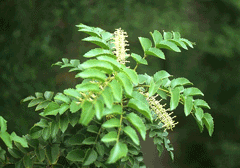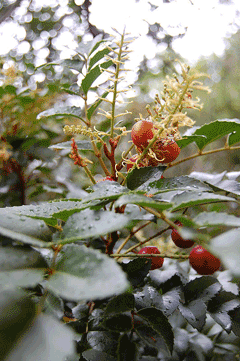 |
|
http://commons.wikimedia.org/wiki/User:Franz_Xaver |
 |
| http://www.flickr.com/photos/91226097@N00 |
Translate this page:
Summary
Physical Characteristics

 Gevuina avellana is an evergreen Shrub growing to 10 m (32ft) by 10 m (32ft) at a slow rate.
Gevuina avellana is an evergreen Shrub growing to 10 m (32ft) by 10 m (32ft) at a slow rate.
See above for USDA hardiness. It is hardy to UK zone 9 and is frost tender. It is in leaf all year, in flower from June to August, and the seeds ripen in October. The species is hermaphrodite (has both male and female organs) and is pollinated by Insects.
Suitable for: light (sandy), medium (loamy) and heavy (clay) soils and prefers well-drained soil. Suitable pH: mildly acid and neutral soils. It can grow in semi-shade (light woodland). It prefers moist soil.
UK Hardiness Map
US Hardiness Map
Synonyms
Plant Habitats
Woodland Garden Secondary; Dappled Shade; Shady Edge; South Wall. By. West Wall. By.
Edible Uses
Edible Parts: Seed
Edible Uses: Coffee
Seed - raw or cooked. A pleasant taste, similar to cob nuts[11, 63, 139, 183]. A popular food in Chile where it is often sold in local markets and is a much sought after item of diet[177]. The seed contains about 12.5% protein, 49.5% oil, 24.1% carbohydrate[183]. The roasted seed is used as a coffee substitute[139].
References More on Edible Uses
Medicinal Uses
Plants For A Future can not take any responsibility for any adverse effects from the use of plants. Always seek advice from a professional before using a plant medicinally.
None known
References More on Medicinal Uses
The Bookshop: Edible Plant Books
Our Latest books on Perennial Plants For Food Forests and Permaculture Gardens in paperback or digital formats.

Edible Tropical Plants
Food Forest Plants for Hotter Conditions: 250+ Plants For Tropical Food Forests & Permaculture Gardens.
More

Edible Temperate Plants
Plants for Your Food Forest: 500 Plants for Temperate Food Forests & Permaculture Gardens.
More

More Books
PFAF have eight books available in paperback and digital formats. Browse the shop for more information.
Shop Now
Other Uses
Tannin Wood
The seedcase is a source of tannin[139]. Wood - light, strong, easily worked, elastic, not very durable. It is used for furniture, oars, roof-shingles etc[46, 117, 139].
Special Uses
Carbon Farming
References More on Other Uses
Cultivation details
Management: Standard New Crop Staple Crop: Oil
Requires a lime-free soil and a sheltered position[182]. Requires a well-drained moist fertile soil[188]. Best grown in semi-shade[200], the plant prefers woodland conditions[166]. A very ornamental plant[1, 117], when dormant it is hardy to -10°c[184] in a sheltered woodland environment, but succeeds outdoors only in the milder areas of Britain, growing well in Devon and Cornwall[11, 59]. The young growth in spring, even on mature plants, is frost-tender and so it is best to grow the plants in a position sheltered from the early morning sun[K]. Plants flower and set viable seed every year at Coleton Fishacre in S. Devon[104]. In general, however, flowering is unreliable in cool temperate zones[200]. The leaves are very variable in shape, ranging from pinnate to bipinnate, the leaflets varying in number from 3 to 30. There is probably some form of symbiotic relationship with a fungus in the soil that the plants are dependant upon. Plants are very intolerant of root disturbance[117].
Carbon Farming
-
Management: Standard
Plants grow to their standard height. Harvest fruit, seeds, or other products. Non-Destructive management systems.
-
New Crop
Most new crops were important wild plants until recently, although some are the result of hybridization. They have been developed in the last few, decades. What they have in common is that they are currently cultivated by farmers. Examples include baobab, argan, and buffalo gourd.
-
Staple Crop: Oil
(0-15 percent protein, 16+ percent oil). Some of these are consumed whole while others are exclusively pressed for oil. Annuals include canola, poppyseed, maize, cottonseed, sunflower, peanut. Perennials include high-oil fruits, seeds, and nuts, such as olive, coconut, avocado, oil palm, shea, pecan, and macadamia. Some perennial oil crops are consumed whole as fruits and nuts, while others are exclusively pressed for oil (and some are used fresh and for oil).
References Carbon Farming Information and Carbon Sequestration Information
Temperature Converter
Type a value in the Celsius field to convert the value to Fahrenheit:
Fahrenheit:
The PFAF Bookshop
Plants For A Future have a number of books available in paperback and digital form. Book titles include Edible Plants, Edible Perennials, Edible Trees,Edible Shrubs, Woodland Gardening, and Temperate Food Forest Plants. Our new book is Food Forest Plants For Hotter Conditions (Tropical and Sub-Tropical).
Shop Now
Plant Propagation
Seed - best sown as soon as it is ripe in a greenhouse. Sow stored seed as soon as possible in the year. The seed often germinates well but then sickens and dies, it has been suggested that this is due to the plants need of a symbiotic relationship with a soil-borne fungus. Adding some soil from around a growing plant to the seed compost might improve success rates. When they are large enough to handle, prick the seedlings out into individual pots and grow them on in the greenhouse for at least their first winter. Plant them out into their permanent positions in late spring or early summer, after the last expected frosts, and consider giving them some protection from the cold for their first winter or two outdoors. Cuttings of half-ripe wood, July/August in a frame. Layering - hard pruning provides lots of material.
Other Names
If available other names are mentioned here
Native Range
SOUTHERN AMERICA: Argentina (Chubut, Neuquén, Río Negro), Chile (Maule)
Weed Potential
Right plant wrong place. We are currently updating this section.
Please note that a plant may be invasive in one area but may not in your area so it's worth checking.
Conservation Status
IUCN Red List of Threatened Plants Status :

Growth: S = slow M = medium F = fast. Soil: L = light (sandy) M = medium H = heavy (clay). pH: A = acid N = neutral B = basic (alkaline). Shade: F = full shade S = semi-shade N = no shade. Moisture: D = dry M = Moist We = wet Wa = water.
Now available:
Food Forest Plants for Mediterranean Conditions
350+ Perennial Plants For Mediterranean and Drier Food Forests and Permaculture Gardens.
[Paperback and eBook]
This is the third in Plants For A Future's series of plant guides for food forests tailored to
specific climate zones. Following volumes on temperate and tropical ecosystems, this book focuses
on species suited to Mediterranean conditions—regions with hot, dry summers and cool, wet winters,
often facing the added challenge of climate change.
Read More
Expert comment
Author
Molina.
Botanical References
11139200
Links / References
For a list of references used on this page please go here
Readers comment